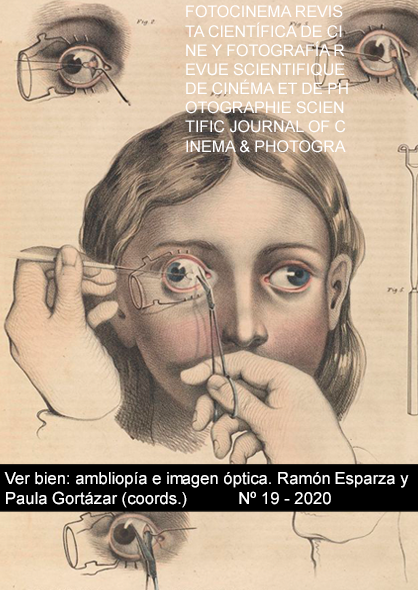Subjective documentary photography in ‘Normalised’ Czechoslovakia (1968-89). Decoding Vladimír Birgus’ work
DOI:
https://doi.org/10.24310/Fotocinema.2019.v2i19.6647Keywords:
Czech photography, Slovak photography, normalization, Objective documentary photography, Vladirmír BirgusAbstract
This paper aims to study the use of a ‘subjective’ view in Czechoslovakian photography through documentary practices developed during the period of ‘normalisation’ (1968-1989). Its intention is to analyse how are we to understand the notion of ‘subjective’ in Czechoslovakian documentary photography and its significance during the last two decades of communist rule in the country. Through the analysis of Vladimír Birgus’ work, the article discusses how the principles of ‘subjectivity’ in photography aided Czechoslovakian photographers to express their reactions against the established power; a reaction that, thanks to the attributes of this ‘subjective view’, was able to remain ‘under-cover’ through the use of a coded visual language in the photograph.
Downloads
Metrics
References
Barthes, R. (1977). The Photographic Message. In Image, Music, Text, edited and translated by Stephen Heath, pp. 15-31. New York: Hill.
Benjamin, W. (1978) (1931). A Short History of Photography. Translated by Stanley Mitchell, Screen 13 (1), pp. 5-26.
Bieleszová, Š. (2014). Photographer. In Vladimír Birgus, Photographs 1972 – 2014, pp. 8-13. Prague: Kant.
Birgus, V. & Jan M. (2005). Czech Photography of the 20th Century. Prague: Kant.
Crampton, R. (2015). Eastern Europe in the Twentieth Century – and After. NY: Routledge.
Dufek, A. (2008). Retrospect. In The Third Side of the Wall. n.p. Prague: KANT.
Dufek, A. (2011). Half a Century of The Moravian Gallery in Brno. In Full Spectrum, pp. 13-35. Prague: KANT.
Fiserová, L. L. & Posp?ch T. (2014). The Slovak New Wave. Prague: Kant.
Gortázar, P. (2019). Towards an Emancipation of Photographic Vision: ‘Visualism’ under Czechoslovakian Normalisation (1968-1989). In Photography and Culture. https://doi.org/10.1080/17514517.2019.1596598
Gortázar, P. (2018). Transitional Frames: From Normalisation to Democracy. Czech and Slovak Art Photography (1968-1998). London: University of Westminster https://ethos.bl.uk/OrderDetails.do?uin=uk.bl.ethos.742308
Mazzone, M. (2009). Drawing Conceptual Lessons from 1968. Third Text 23 (1), pp. 74–84.
Morganová, P. (2012). Czech Art of the 20th and 21st Centuries. In Czech Contemporary Art Guide, edited by Lucie Šev?íková and Eva Žáková, pp-13-18. Prague: The Arts and Theatre Institute.
Posp?ch, T. (2003). Introduction. In Vladimír Birgus: Something Unspeakable. Prague: KANT.
Šlachtová, A. (1976). Vladimír Birgus – Fotigrafie. Brno: Galerie mladych.
Shklovsky, V. (1991) (1925). Art as Device. In Theory of Prose, translated by Benjamin Sher, pp. 1-14. Illinois: Dalkey Archive Press.
Downloads
Published
How to Cite
Issue
Section
License
All contents published in Fotocinema Revista científica de cine y fotografía are protected under the Creative Commons Attribution-NonCommercial-ShareAlike 4.0 International (CC BY-NC-SA 4.0) license. All about this license is available in the following link: <http://creativecommons.org/licenses/by-nc-sa/4.0>
Users can copy, use, redistribute, share and exhibit publicly as long as:
- The original source and authorship of the material are cited (Journal, Publisher and URL of the work).
- It is not used for comercial purposes.
- The existence of the license and its especifications are mentioned.
There are two sets of authors’ rights: moral and property rights. Moral rights are perpetual prerogatives, unrenounceable, not-transferable, unalienable, imprescriptible and inembargable. According to authors’ rights legislation, Fotocinema. Revista científica de cine y fotografía recognizes and respects authors moral rights, as well as the ownership of property rights, which will be transferred to University of Malaga in open access. The property rights are referred to the benefits that are gained by the use or the dissemination of works. Fotocinema. Revista científica de cine y fotografía is published in an open access form and it is exclusively licenced by any means for doing or authorising distribution, dissemination, reproduction, , adaptation, translation or arrangement of works.
Authors are responsable for obtaining the necessary permission to use copyrighted images.













13.png)




